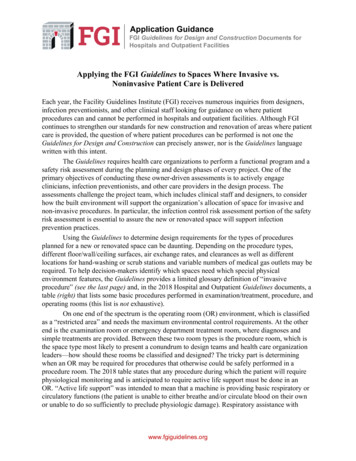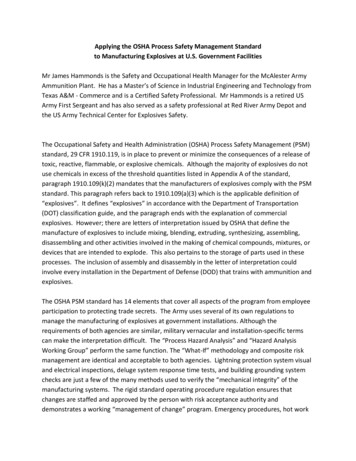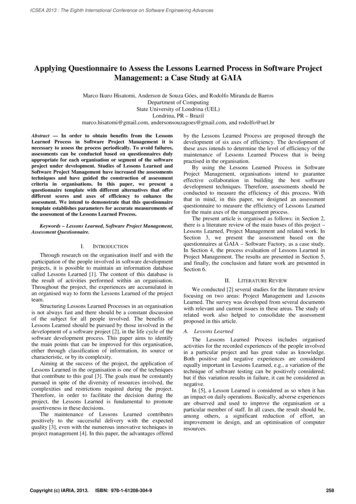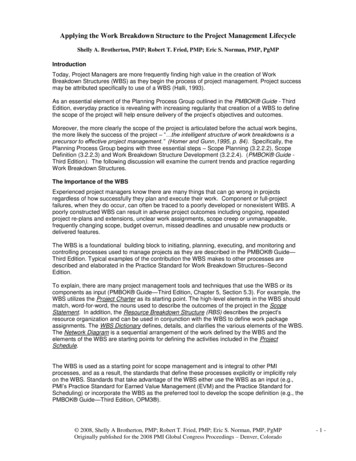
Transcription
Application GuidanceFGI Guidelines for Design and Construction Documents forHospitals and Outpatient FacilitiesApplying the FGI Guidelines to Spaces Where Invasive vs.Noninvasive Patient Care is DeliveredEach year, the Facility Guidelines Institute (FGI) receives numerous inquiries from designers,infection preventionists, and other clinical staff looking for guidance on where patientprocedures can and cannot be performed in hospitals and outpatient facilities. Although FGIcontinues to strengthen our standards for new construction and renovation of areas where patientcare is provided, the question of where patient procedures can be performed is not one theGuidelines for Design and Construction can precisely answer, nor is the Guidelines languagewritten with this intent.The Guidelines requires health care organizations to perform a functional program and asafety risk assessment during the planning and design phases of every project. One of theprimary objectives of conducting these owner-driven assessments is to actively engageclinicians, infection preventionists, and other care providers in the design process. Theassessments challenge the project team, which includes clinical staff and designers, to considerhow the built environment will support the organization’s allocation of space for invasive andnon-invasive procedures. In particular, the infection control risk assessment portion of the safetyrisk assessment is essential to assure the new or renovated space will support infectionprevention practices.Using the Guidelines to determine design requirements for the types of proceduresplanned for a new or renovated space can be daunting. Depending on the procedure types,different floor/wall/ceiling surfaces, air exchange rates, and clearances as well as differentlocations for hand-washing or scrub stations and variable numbers of medical gas outlets may berequired. To help decision-makers identify which spaces need which special physicalenvironment features, the Guidelines provides a limited glossary definition of “invasiveprocedure” (see the last page) and, in the 2018 Hospital and Outpatient Guidelines documents, atable (right) that lists some basic procedures performed in examination/treatment, procedure, andoperating rooms (this list is not exhaustive).On one end of the spectrum is the operating room (OR) environment, which is classifiedas a “restricted area” and needs the maximum environmental control requirements. At the otherend is the examination room or emergency department treatment room, where diagnoses andsimple treatments are provided. Between these two room types is the procedure room, which isthe space type most likely to present a conundrum to design teams and health care organizationleaders—how should these rooms be classified and designed? The tricky part is determiningwhen an OR may be required for procedures that otherwise could be safely performed in aprocedure room. The 2018 table states that any procedure during which the patient will requirephysiological monitoring and is anticipated to require active life support must be done in anOR. “Active life support” was intended to mean that a machine is providing basic respiratory orcirculatory functions (the patient is unable to either breathe and/or circulate blood on their ownor unable to do so sufficiently to preclude physiologic damage). Respiratory assistance withwww.fgiguidelines.org
Updated 10/24/19*general anesthesia or mechanical ventilation are examples of what the Health GuidelinesRevision Committee intended by “active life support.”In the 2018 Guidelines for Design and Construction of Hospitals and Guidelines forDesign and Construction of Outpatient Facilities, a new imaging room classification system wasintroduced to help designers and clinicians determine what room types are needed for a newimaging facility. The imaging classes correspond with the exam/treatment, procedure, andoperating rooms: Class 1 imaging room for diagnostic procedures, Class 2 imaging room fordiagnostic and therapeutic procedures, and Class 3 imaging rooms, which are ORs with mobileor built-in imaging equipment (the latter is defined as a hybrid OR), for invasive procedures (i.e.,surgery). Like the conundrum of the procedure room described above, the distinction betweenwww.fgiguidelines.org
Updated 10/24/19*when a Class 2 and a Class 3 imaging room is needed is the most difficult to determine. The2018 edition also includes a table (left) to help users understand the differences between theseimaging room types.While guidance is provided in the Guidelines for newly constructed procedure and Class2 imaging rooms, the final decision must be based on a clinical assessment of procedures to beperformed in the rooms and the environmental needs of the most stringent procedure that will beperformed in a given space. With nearly constant advancements in non-invasive medicalprocedures, even the best plans may change before a new facility is occupied, so thewww.fgiguidelines.org
Updated 10/24/19*recommended goal is rooms designed to flex so they can support procedure types health careorganizations may want to perform in them in the future.How a space is used after occupancy is something the Guidelines cannot control. Forexample, a cardiac catherization may begin as a procedure where a catheter is inserted into anartery or a vein in the groin, neck, or arm and threaded through blood vessels to the heart.However, in some instances, the procedure may be converted to a surgery in which closure ofholes in the heart, repair or replacement of heart valves, balloon valvuloplasty, or other invasiveprocedures are performed. As the invasiveness of the procedure increases, so do the infectioncontrol requirements of the Guidelines. A room designed for one level of procedure that is usedfor a more invasive procedure is no longer the safest environment for patients or staff. Thus, ahealth care organization should assess how often their cardiac cath procedures turn into openheart surgery to determine how many Class 2 and Class 3 imaging rooms are needed.A reminder: Keep in mind that the FGI Guidelines requirements are developed and adopted foruse on new construction or major renovations of hospitals, outpatient facilities, and residentialhealth, care, and support facilities. They are not intended to be applied retroactively or used toevaluate whether an existing space is appropriate for the procedures being performed in it. Thesedecisions are the responsibility of the health care organization and the enforcing authority(ies).FGI will continue to work with national associations, authorities having jurisdiction, health careorganizations, and the design community to provide the best guidance we can for specifyingelements of the built environment for safe patient care.Further InformationShould you wish to delve deeper into how to determine whether a facility needs a procedureroom or an operating room or a Class 2 or Class 3 imaging room, FGI has produced a series ofcontinuing education webinars (offered through MADCAD), two of which explore this issue ingreater depth. For more information, visit www.fgiguidelines.org or fgi.madcad.com/webinars.To sign up for access, please visit fgi.madcad.com.The tables in this article are excerpted from the 2018 FGI Guidelines for Design andConstruction of Hospitals. The same tables also appear in the 2018 FGI Guidelines for Designand Construction of Outpatient Facilities as Table 2.1-5 (Examination/Treatment, Procedure,and Operating Room Classification) and Table 2.1-6 (Classification of Room Types for ImagingServices). An error in the tables has been corrected on the errata sheet for each document;download current errata sheets from this page on the FGI website.2018 FGI Guidelines glossary definition of invasive procedure: A procedure that is performedin an aseptic surgical field and penetrates the protective surfaces of a patient’s body (e.g.,subcutaneous tissue, mucous membranes, cornea). An invasive procedure may fall into one ormore of the following categories: Requires entry into or opening of a sterile body cavity (i.e., cranium, chest, abdomen,pelvis, joint spaces) Involves insertion of an indwelling foreign body Includes excision and grafting of burns that cover more than 20 percent of total body areawww.fgiguidelines.org
Updated 10/24/19* Does not begin as an open procedure but has a recognized measurable risk of requiringconversion to an open procedureNote: Invasive procedures are performed in locations suitable to the technical requirements ofthe procedure with consideration of infection control and anesthetic risks and goals. Acceptedstandards of patient care are used to determine where an invasive procedure is performed.“Invasive procedure” is a broad term commonly used to describe procedures ranging from asimple injection to a major surgical procedure. For the purposes of this document, the term islimited to the above description. The intent is to differentiate those procedures that carry a highrisk of infection, either by exposure of a usually sterile body cavity to the external environmentor by implantation of a foreign object(s) into a normally sterile site. Procedures performedthrough orifices normally colonized with bacteria and percutaneous procedures that do notinvolve an incision deeper than skin would not be included in this definition.*An error in the procedure room “use” description in Table 2.2-1 was corrected on the 2018 HospitalGuidelines and Outpatient Guidelines errata sheets on September 13, 2019. The corrected table wasadded to this guidance sheet on October 24, 2019.www.fgiguidelines.org
heart surgery to determine how many Class 2 and Class 3 imaging rooms are needed. A reminder: Keep in mind that the FGI Guidelines requirements are developed and adopted for use on new construction or major renovations of hospitals, outpatient faciliti











